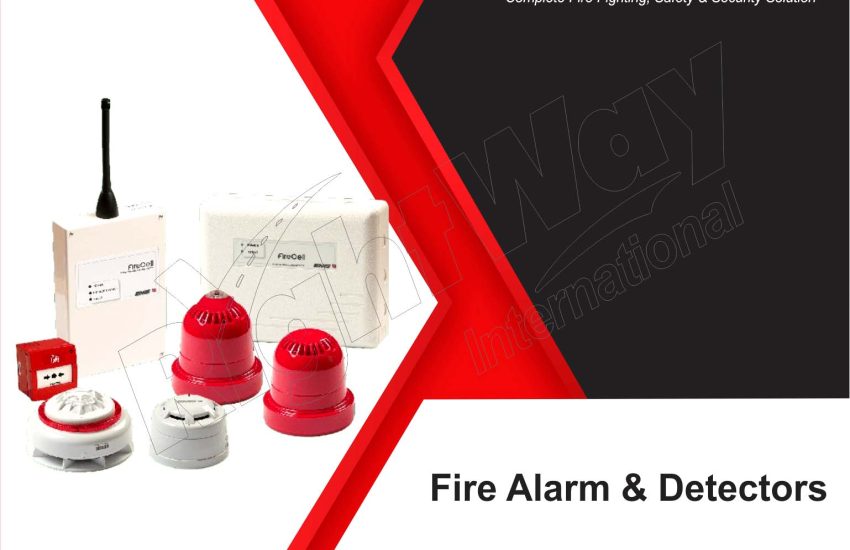Fire Alarm and Detectors in Pakistan Fire safety is crucial in residential, commercial, and industrial spaces. Fire alarms and detectors are essential components of any fire safety system. These devices detect smoke, heat, or gas and alert occupants about potential fire hazards. This guide explores the importance of fire alarms, the different types of detectors, installation tips, and maintenance guidelines.
What Are Fire Alarm and Detectors in Pakistan?
A fire alarm system detects fires or smoke and triggers an alert, such as an audible alarm or visual signals, to warn people nearby. A fire detector is the sensor part of the system, responsible for detecting smoke, heat, or carbon monoxide (CO) in the environment.
Why Are Fire Alarms and Detectors Important for Fire Safety?
The primary role of fire alarms and detectors is to save lives by providing early fire warnings. Early detection allows people to evacuate quickly. It also gives firefighters time to control and contain the fire before it spreads. A properly installed fire alarm system can reduce property damage and prevent loss of life.
Types of Fire Detectors and Alarms
1. Smoke Detectors
Smoke detectors are the most common fire alarm sensors. They detect smoke particles in the air and trigger an alarm. Two main types exist:
- Ionization Smoke Detectors: These are best for detecting fast-flaming fires. They use a small amount of radioactive material to ionize the air in a chamber. When smoke enters, it disrupts the ionization process and triggers the alarm.
- Photoelectric Smoke Detectors: These detectors use a light beam to detect smoke. When smoke scatters the light, the alarm goes off. They are better at detecting smoldering fires.
2. Heat Detectors
Heat detectors activate when the temperature in a room rises significantly. There are two main types:
- Fixed Temperature Heat Detectors: These activate when the temperature exceeds a set threshold (usually around 135°F or 57°C).
- Rate-of-Rise Heat Detectors: These detect a rapid increase in temperature, regardless of the baseline temperature. They are ideal for fast-developing fires.
3. Carbon Monoxide (CO) Detectors
Carbon monoxide detectors detect CO, a colorless and odorless gas that results from combustion. High levels of CO may indicate a fire hazard or a malfunctioning heating system.
4. Flame Detectors
Flame detectors are used in industrial settings. They detect the infrared radiation emitted by flames, especially in areas with high smoke or steam, where other detectors may fail.
5. Combination Smoke and Carbon Monoxide Detectors
Modern detectors often combine smoke detection and carbon monoxide detection into one device. These are ideal for residential settings, offering dual protection from both threats.
Key Features of Fire Alarm Systems
- Audible and Visual Alerts: Fire alarms emit loud sirens, bells, or chimes to alert people. Visual signals, like flashing lights, help those with hearing impairments.
- Automatic Fire Suppression: In some systems, alarms are linked to fire suppression systems, like sprinklers, which can control the fire while people evacuate.
- Remote Monitoring: Many commercial fire alarms include remote monitoring, allowing emergency responders to be notified in real-time.
- Battery Backup: Most fire alarm systems include a battery backup to continue functioning during a power outage.
Why Regular Maintenance is Essential for Fire Detectors and Alarms
For a fire alarm system to be effective, it must be properly maintained. Regular checks ensure the system functions properly in an emergency. Here’s why maintenance matters:
- Early Detection of Malfunctions: Smoke detectors and heat detectors may get clogged with dust, debris, or insects, preventing proper function.
- Testing: Test smoke detectors and heat detectors regularly to ensure they detect fire hazards. Replace batteries regularly, and replace faulty detectors immediately.
- Compliance: Many local building codes and insurance policies require regular maintenance to meet fire safety standards.
Installation Tips for Fire Alarms and Detectors
- Strategic Placement: Install smoke detectors on the ceiling or high on the walls. Smoke rises, so this ensures quicker detection. Avoid placing detectors near windows, doors, or vents, as drafts can affect their performance.
- Room Size Considerations: Large rooms may require multiple detectors to ensure complete coverage.
- Install Near Escape Routes: Place detectors near hallways and stairwells for early warning during evacuations.
- Avoid Kitchens: Do not place smoke detectors in kitchens where cooking smoke can trigger false alarms. Use heat detectors in kitchens instead.
Conclusion: Fire Alarms and Detectors in Pakistan
Fire Alarm and Detectors in Pakistan Investing in high-quality fire alarms and detectors is crucial for safety. Understanding the different types of detectors, their key features, and the importance of regular maintenance helps you choose the right system. By installing, testing, and maintaining your fire alarm system, you can ensure quick responses in the event of a fire and protect your property and loved ones.


